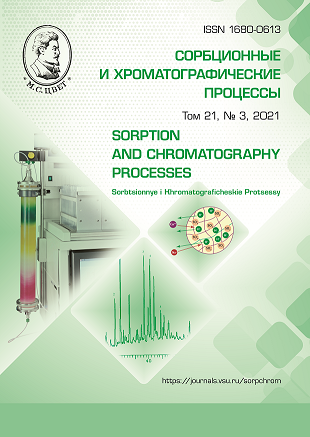Study of the regularities of the deposition of thin sorption-active films of manganese dioxide on various polymeric carriers
Abstract
Manganese dioxide (MnO2) is used as a sorption material for the isolation of a wide range of substances from aqueous media. A number of composite materials containing MnO2 are known, while in the scientific literature there are no systematic data on the possibilities of obtaining flat thin-layer sorbents of manganese dioxide on other polymer carriers. In this study, a number of flat thin-layer sorbents, consisting of manganese dioxide deposited on the surface of various carriers, were synthesized. The most common flat materials were used as carriers - polyethylene (PE), polypropylene (PP), biaxially oriented polypropylene film (BOPF), polyethylene terephthalate (PET), cellulose triacetate (CTA). The films were kept in an acidic solution of potassium permanganate, washed, and the manganese content was determined. It was shown that according to the rate of deposition of manganese dioxide on the surface of the carrier, these materials are arranged in a row: CTA >> PE> BOPF> PET ≈ PP. It was found that the dependences of the specific content of manganese dioxide on the surface of polymer carriers were well approximated by straight lines (R2 = 0.964 - 0.997); the results of linear processing of the dependences were used to determine the deposition rates of manganese dioxide, ranging from 1.55 ± 0.26 μg/(cm2∙day) for PP up to 166 ± 11 μg/(cm2∙day) for CTA. It was shown that the high rate of deposition of manganese dioxide on the surface of the CTA in comparison with other polymer carriers was most likely due to the macroporous texture of the CTA surface. It was also shown that with a specific content of manganese dioxide of the order of 150-300 μg/cm2 achieved after
1-2 days of CTA treatment in a permanganate solution, a continuous uniform sorption-active layer was formed, and with a longer exposure time, an increase in the average layer thickness occurred due to the growth of individual crystallites already on the surface of a continuous layer of manganese dioxide, leading to a significant heterogeneity of the sorption-active surface, as well as to a stable deformation of the film. The sorption of 223Ra was studied on a series of obtained sorbents. It was shown that the amount of manganese dioxide phase in the composition of thin-layer sorbents had practically no effect on the sorption of radium from a salt-free solution, but strongly influenced sorption from 0.5 M NaCl. Also, for the MnO2-CTA sorbent the deterioration of the quality of the alpha spectrum due to the diffusion of radium deep into the sorbent was demonstrated.
Downloads
References
Ajith N., Swain K.K., Separation Sci-ence and Technology, 2019, Vol. 55, Issue 9, pp. 1715-1723.
Shima J., Kumar M., Mukherjee S., Goswami R., Journal of Environmental Management, 2019, Vol. 234, pp. 8-20.
Yang C., Zhong Y., Li L., Ren X. et al., Journal of Radioanalytical and Nuclear Chemistry, 2018, Vol. 317, pp.1399-1408.
Zuba I., Polkowska‑Motrenko H., Jour-nal of Radioanalytical and Nuclear Chemis-try, 2019, Vol. 322, pp. 969-974.
Yang C., Niu D., Zhong Y., Li L. et al., Journal of Radioanalytical and Nuclear Chemistry, 2018, Vol. 315, pp. 533-542.
Ohnuki T., Kozai N., Radiochimica Acta, 1995, Vol. 68, pp. 203-207.
Al Lafi A.G., Al Abdullah J., Amin Y., Alnama T. et al., Journal of Radioanalytical and Nuclear Chemistry, 2019, Vol. 321, pp. 463-472.
Egorin A., Sokolnitskaya T., Azarova Y., Portnyagin A. et al., Journal of Radioanalyt-ical and Nuclear Chemistry, 2018, Vol. 317, pp. 243-251.
Eikenberg J., Bajo S., Beer H., Hitz J. et al., Applied Radiation and Isotopes, 2004, Vol. 61 (2-3), pp. 101-106.
Moon D.S., Burnett W.C., Nour S., Horwitz P. et al., Applied Radiation and Iso-topes, 2003, Vol. 59, pp. 255-262.
Kamran U., Heo Y.-J., Lee J. W., Park S.-J., Journal of Alloys and Compounds, 2019, Vol. 794, pp. 425-434.
Wu S., Xie M., Zhang Q., Zhong L. et al., Molecules, 2017, Vol. 22, pp. 1117.
Shen Q., Wang Z., Yu Q., Cheng Y. et al., Environmental Research, 2020, Vol. 183, pp. 109195.
Ivanets A.I., Katsoshvili L.L., Krivosh-apkin P.V., Prozorovich V.G. et al., Radio-chemistry, 2017, Vol. 59, pp. 264-271.
White D.A., Labayru R., Industrial & Engineering Chemistry Research, 1991, Vol. 30, pp. 207-210.
Valsala T.P., Joseph A., Sonar N.L., Sonavane M.S., et al., Journal of Nuclear Materials, 2010, Vol. 404, pp. 138-143.
Rao S.V.S., Mani A.G.S., Karua S., Cheralathan M. et al., Journal of Radioana-lytical and Nuclear Chemistry, 2016, Vol. 307, pp. 463-469.
Veleshko A.N., Kulyukhin S.A., Ve-leshko I.E., Domantovskii A.G. et al., Radio-chemistry, 2008, Vol. 50, pp. 508-514.
Yang Z., Chen J., Yang K., Zhang Q. et al., Journal of Colloid and Interface Science, 2020, Vol. 570, pp. 182-196.
Karamanis D., Ioannides K.G., Stamou-lis K.C., Analytica Chimica Acta, 2006, Vol. 573-574, pp. 319-327.
Ra-NucFilm Disc (technical sheet). Available at: https://www.triskem-international.com/scripts/files/59bd7516ebe5f0.12161231/ft_nucfilmdiscs_en_151210.pdf (Acessed: 15 January 2021).
Betenekov N.D., Radiochemistry, 2018. Vol. 60, Issue 5, pp. 552-557.







